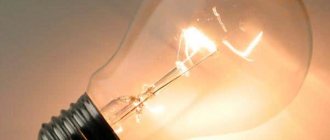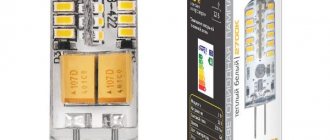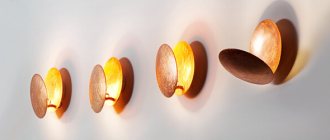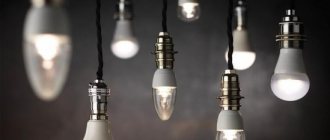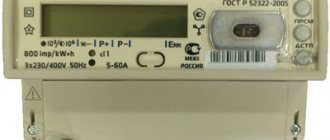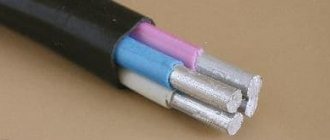Today, LED lamps, created on the basis of semiconductor technology, are used in many areas of human activity. They successfully combine reliability, efficiency, safety in operation, and reasonable cost. LED lamps are replacing outdated incandescent lamps and are widely used in everyday life, in production, indoors and outdoors, becoming part of everyday use:
- when organizing household lighting in apartments, in the form of wall and ceiling lamps, chandeliers, sconces;
- for advertising lighting, where luminous letters and signs, illuminated figures and lightboxes are used;
- for architectural lighting of buildings;
- in illumination of flower beds in squares and gardens;
- in floodlights for various purposes and powerful car headlights;
- as festive lighting for family celebrations.
As practice shows, LED lighting has become an optimal replacement for incandescent, halogen and fluorescent lamps, as it has numerous advantages.
Next, we will take a detailed look at the advantages of LED lighting in comparison with other lighting systems and devices, and also touch on their disadvantages. But first you need to understand how LED light sources work.
How LED works - the principle of operation of LED lamps
To understand how LED backlighting works, you should take a closer look at the operating principle of an LED lamp. The first light-emitting diode elements appeared in 1961. And, starting from the late 90s of the last century, LED lighting has spread massively across countries and continents.
The operating principle of light-emitting diodes is based on the passage of electric current through the contact zone of two semiconductors. In this case, optical radiation visible to us appears. The light emitted by an LED is in a narrow range of the spectrum. It is related to the type and chemical composition of the starting materials. For long-term uninterrupted operation of LED light sources, a constant current is required that does not exceed the permissible limits. Excess current is especially critical for LEDs. To maintain the required values, the circuit uses a current stabilizer or LED lamp driver. In general, this electronic circuit rectifies the alternating current and maintains its set value, which ensures uninterrupted and long-lasting operation of the LED lamp. Drivers can be linear or pulsed, with or without a housing, with a different set of functions, designed for different LED powers, and their cost can vary significantly. Cheap equipment usually uses inexpensive drivers that do not perform the function of current stabilization, and the service life of LEDs in such equipment is not so long.
The issue of increasing temperature is solved by a radiator, which removes the generated heat from the LED.
Based on the described principle of operation of LED lamps, a wide range of lighting equipment is produced today. The luminous flux power can vary depending on the number of LEDs, so the scope of application of these lamps is very wide. They are implemented in the form:
- lamps and spotlights of various power, size, format and purpose,
- LED strips, tubes and cords,
- various garlands,
- light figures.
What are the options?
Currently, there are many options, each of which has its own characteristics, disadvantages, specifics of operation, technical characteristics and a number of other significant points. The choice must be made based on the complexity of the task, budget, and personal preferences.
Fluorescent and induction lamps
The devices have become most widespread. They have a number of advantages and disadvantages. A significant disadvantage is the presence of mercury in their composition. A good choice, but less well known, are induction lamps, in which light arises as a result of electromagnetic induction in a gas environment filling the bulb of the lighting device. They also contain harmful substances, namely solid-state mercury, which significantly complicates disposal processes. Since the devices emit electromagnetic radiation, it is not advisable to install them below 6 meters from the floor level.
LED lights
Every year they are gaining more and more popularity. Therefore, many potential and actual consumers have many questions and doubts regarding the safety, durability and feasibility of their purchase. Modern LED lighting, chandeliers and lamps are designed for standard sockets and have various shapes. Separately, it is necessary to note the LED strips, which are used to illuminate furniture, cornices, and ceiling space and ensure the creation of the required lighting scenarios.
An excellent choice is to purchase devices with integrated LED modules. They are offered in different shapes, sizes, types, and therefore attract the attention of designers and interior designers. Such LED lamps are more suitable for office spaces, industrial premises, connoisseurs of modern, classic, and country styles. Recently, they can be increasingly found in residential buildings, forming the main and spot lighting.
Filament lamps
They are considered a new generation of LED lighting devices. Their work is based on Chip Glass technology, which was previously used to create mobile device screens. Its essence lies in the use of very small diodes on a special substrate made of sapphire (a more affordable alternative may be a special type of glass). The transparent base ensures that the LED elements glow in different directions. Existing lamp models can use both blue and red light. The total number of LEDs is 28 units with a serial connection.
All LED elements are treated with a layer of silicone-based phosphor. Note that one filament consumes up to 1.3 W of electricity. Thus, it is easy to create lamps with the required power. The advantage of such a lighting device, the resulting LED light, is the simplicity of the design, the absence of the need to use a complex optical system (which causes energy losses). Therefore, filament lighting sources are characterized by high efficiency, 1.5 times higher than traditional LED lamps (provided the same luminous flux). The above also leads to a significant reduction in collateral heat generation.
Advantages of LED lamps and LED luminaires
LED lighting has many positive characteristics. The advantages of LED lamps are many times greater than those of the traditional lighting systems we are used to, which use incandescent, halogen or fluorescent lamps. Therefore, LED lighting is gradually displacing outdated types of lighting devices from the market.
Let's look at the main advantages of LED lamps:
- One of the main advantages of LED lamps is the tangible energy savings of LED lamps. The high light output of these lighting devices is achieved due to the fact that 80% of the energy consumed is converted into light, and only 20% is heat. The outdated option - incandescent lamps - emit up to 85-90% of the energy along with thermal radiation. With such lighting, your financial costs for paying energy bills are significantly reduced.
- Another advantage of LED is the long service life of LED lamps, which is equivalent to 10-11 years of continuous operation. They have a long service life with minimal loss of brightness. For comparison, the average operating time of an LED lamp ranges from 20 to 50 thousand hours, depending on the manufacturer and the components used. Its closest competitors are luminescent devices, for which these indicators vary between 2-90 thousand hours. Today's outdated incandescent lamps can last up to 1000 hours. The service life of halogen lamps is 2000-4000 hours. The obvious advantage of LED lamps over incandescent and halogen lamps is their longer service life.
- The relatively low level of heating is another advantage of LED lamps. LEDs produce a small amount of heat. They hardly heat up during operation, so another advantage of LED lamps is their high fire safety.
- A wide operating temperature range is inherent in all LED devices. Thanks to the high degree of protection from external aggressive factors, they will work both in heat of + 50°C and in frost down to - 40°C.
- Eco-friendliness and safety for health and the environment also distinguish LED lighting from its analogues. Such devices do not contain zinc or mercury, which are used in luminescent or halogen analogs, so their operation and disposal do not pose a threat to consumers and the environment.
- Relatively low weight is another undeniable advantage of LED lamps. They can be used in a wide variety of types of lighting equipment - from mini-lamps and backlights to powerful spotlights.
- An important operational advantage of LED lamps is the flexibility of their use. Based on this technology, a huge number of different types of lighting devices have been created, of different power, light parameters, size, method of application, lamp base format. This includes lamps of various formats, flexible strips and tubes, garlands, spotlights, volumetric light figures and LED ceiling lamps. A variety of lamp form factors (“candle in the wind”, pear-shaped, oval, “mushroom”, “ball”) allows you to find the lamp that best suits your interior.
- Among the advantages of LED lighting is the ability to change the color of RGB lamps. This option allows you to adjust the brightness and color scheme of the device for the specific needs of the consumer: create decorative lighting, get a night light with a weak glow, or illuminate the space as much as possible.
Of particular interest are devices with a concentrated luminous flux - spotlights. Having low weight and small dimensions, such a compact lamp has the ability to produce a powerful light beam. At the same time, the energy consumption of the device is minimal. These advantages of LED floodlights are successfully used in housing and communal services and the manufacturing sector.
Thus, energy efficiency, long service life, large choice of formats and safety are the main advantages of LED lighting.
Advantages of LEDs
So, the first and most important advantage is energy efficiency . The electric current in the LED is converted directly into light quanta - photons. Such a transformation theoretically occurs without loss of energy - as much energy is spent, so much is emitted. In practice, of course, there are losses, but impressive results have already been achieved compared to other sources. The light distribution of the luminaire is created with much less light loss.
Reliability and lifetime . Let's start with the definition of the device's lifetime. For an LED, the lifetime is taken to be the number of hours it will work before its luminous flux decreases by 30%. Leading manufacturers (for example, Osram) claim a lifetime of more than 100 thousand hours.
{xtypo_quote}Compare: incandescent lamp – 1000 hours, standard fluorescent lamp – 12 thousand hours, gas discharge lamps – up to 40 thousand hours. Data on traditional light sources are given based on the criterion of complete failure of the source. {/xtypo_quote}
Small LED size . The powerful one-watt LED of the OSLON series produced by Osram has a housing size of 3x3 mm. This allows you to fit it into any lamp design, as well as create miniature and at the same time very powerful lighting fixtures. (Fig. 3). Environmental Safety.
The LED itself contains hundredths of a gram of the substance in a crystalline, extremely chemically inert form. A fluorescent light bulb contains substances that are very dangerous to humans and nature, such as mercury. Disposing of such lamps is an expensive and complex process.
On-off time and brightness control . The LED requires fractions of microseconds (150 ns for the white 1-watt Golden Dragon Plus LED) to operate at full capacity once electrical current is applied to it. This makes it possible to regulate the luminous flux by supplying short current pulses at a high frequency.
Thus, the brightness of the lamp can be adjusted within any limits while maintaining 100% efficiency. One more effect can be noted - the LED is not critical to the number of on-off cycles, which is the bane of, for example, inexpensive energy-saving lamps.
Mechanical strength and shock resistance . An LED is a solid crystal in a plastic or ceramic shell. If desired, it can be destroyed with a hammer. In practice, it is absolutely insensitive to vibrations and other influences typical of industrial applications.
Stable operation at low temperatures without reducing service life or loss of brightness. The LED lamp does not require startup; it reaches the set temperature almost instantly.
Disadvantages of LED lamps
Despite a number of significant advantages of LED, LED lighting has some disadvantages. Just a few years ago, the first place among the disadvantages of LED equipment was its price. But now the cost of the most popular household LED lamps has dropped to an affordable 100-200 rubles. Other functional characteristics came to the fore:
- The disadvantages of LED light sources include the need for a mandatory heat sink for powerful lamps. Their modest dimensions do not allow sufficient heat dissipation; this role is assigned to the built-in radiator. This fact complicates the creation of lamps whose power exceeds 15 W, since the radiator will have impressive dimensions exceeding 100 cm2. In addition, their cost will become much higher;
- Compared to sodium lamps, the luminous flux power of LED devices is somewhat lower, which limits the possibility of their use in street lamps;
- Low-quality lamps, which the domestic market is full of, have one drawback that is dangerous to health: LED lamps flicker during operation, which can negatively affect the health of human eyes. In addition, the blue spectrum of such lamps does not correspond to natural daylight and can cause drowsiness, headaches, and even disrupt a person’s circadian rhythms.
To appreciate the advantages of LED lamps over incandescent, halogen and fluorescent lamps, as well as to avoid the negative consequences of using low-quality products, you should give preference to reliable products from trusted suppliers. Then the risks of material damage and harm to health will be minimized.
Operating principle and design of light diodes
A diode that emits light consists of a substrate and a crystal. The substrate can be of any shape, the most common being square. A reflector and lens are applied to the body. The crystal is placed on the reflector. Light is emitted when an electric current passes through the pn junction of the crystal.
To connect to the network, there are two (or more) pins (anodes and cathodes), some of which are connected to the crystal. The lens is most often made of a transparent polymer; its main purpose is to determine the direction of the beam and the scattering angle.
The reason for the glow of the crystal is the recombination of electrons and holes at the pn junction formed by two semiconductors with different conductivities. The movement of particles is ensured by impurities (donors and acceptors). It is important that the crystal does not have any defects that would prevent it from emitting a visible light beam. To ensure such characteristics in practice, the crystal is made multilayer.
To get a white glow, you need to:
- mix colors using RGB technology;
- apply a phosphor to the ultraviolet-emitting crystal, creating red, green and blue colors;
- Apply green and red phosphor to the blue diode.
Each of these methods has pros and cons. RGB allows you to obtain different color temperatures and change the current passing through the diodes to change the hue. The presence of several crystals in the body makes it possible to increase the strength and flow of light. The disadvantage is that the color is not the same at the edges and in the middle, which leads to overheating and uneven aging.
The use of a phosphor allows you to reduce the cost of LEDs without losing the quality of white color. But the light output is lower, it is difficult to apply the phosphor evenly, so the light temperature is not determined accurately. The main disadvantage is that the phosphor ages faster than the crystal.
Attention! The scope of LEDs depends on the production technology. For the manufacture of lighting devices, diodes with phosphors are mainly used (only RGB strips are made).
By design, LEDs are divided into:
- DIP;
- SMD;
- powerful;
- filamentous;
- COB;
- OLED;
- fiber.
DIP LEDs are needed to make indicator lights. The diameter of the case is 3 or 5 mm; a crystal and a wire connecting it to the anode, and a diffuser are installed in the case. For connection to the network, there are 2 terminals on the case - cathode and anode.
Powerful diodes create an intense luminous flux at a current of up to 1.4 A. The crystal generates a lot of heat, so it is installed on an aluminum radiator, which simultaneously functions as a reflector. To ensure the required level of electric current, a special limiting driver is included in the circuit, which simultaneously stabilizes the voltage.
LED filament lamps are popular among designers due to their external similarity to incandescent lamps. The case is made of ordinary or sapphire glass up to 1.5 mm thick, coated with a phosphor, 28 semiconductors are connected in series and mounted on a substrate. The main advantage is the light dispersion angle of up to 360 degrees.
COB LED (or Chip-On-Board) belongs to the group of the most modern. A large number of crystals are placed on an aluminum (or glass) substrate and coated with a phosphor. COB shines evenly across the entire lens area. These glowing diodes are used in the production of tablets, laptops and televisions. They work the same way as DIPs.
OLED LEDs used in the production of miniature smartphones, tablets, and TVs consist of:
- substrates (plastic, glass, foil);
- polymer layers;
- organic substance that conducts current;
- tin and indium oxide anode;
- aluminum cathode.
Cons of LED lighting
The disadvantages of diode lighting include the following characteristics:
- The main disadvantage of LEDs is their high cost. Prices continue to decline due to increased mass production. However, they are still several times higher than incandescent light bulbs. A diode analog (in terms of power) of an incandescent lamp for 50-100 rubles will cost at least 300 rubles. It should be noted that, despite the high cost, in the long term, LED products are significantly ahead of their competitors in terms of profitability of the purchase.
- LEDs are not compatible with indicator-type switches or standard dimmers. However, this disadvantage can be circumvented by purchasing a special light bulb suitable for working with a dimmer.
- Although the diodes generate a little heat, this is still enough energy to heat the electronic components of the device. As a result, the driver may fail. Special radiators, purchased separately, help to avoid overheating. However, the cost of the lighting device increases.
So, LED bulbs have relatively few disadvantages. There are clearly more advantages, and they are much more significant.
Summary
There is no doubt that the advantages of LED lamps outweigh the disadvantages. Constant development and improvement of technologies in the manufacture of LED lamps helps to increase efficiency and reduce cost. A high degree of energy efficiency is a relevant aspect in the context of constantly rising energy prices, including electricity. You can discuss the advantages and disadvantages of this lighting technology, but it is worth remembering that energy-saving technologies are the future, and the era of widespread incandescent lamps is coming to an end.
Low voltage.
Effective use of LED lighting does not require high voltage, which makes it effective during use in outdoor installations. This is also true for remote and rural regions.
These 10 advantages of using LED lighting are just the tip of the iceberg, as every year developers and specialists are finding more and more applications for LEDs, and what is noteworthy is that each application is more effective than the other.
If this does not convince you to urgently change traditional lighting to LED, it is worth remembering the fact that by installing LEDs you not only save money, but also help the planet preserve and subsequently accumulate its resources.
About the variety of profile lamps
Photo: “Lamps, Malaya Ordynka 39” So-called linear lamps are created based on LED strips. They are a profile with an LED strip connected inside. Such lamps are universal: they can be used both in technical rooms and for lighting public and residential interiors. The body of some profile models has a compartment for the power supply, which significantly improves the appearance of the finished luminaire. Installation of lamps is carried out using special fasteners for surface-mounted or suspended installation.
Linear luminaires can be used for both main and local lighting. The advantage of such devices is their relatively small depth, limited by the thickness of the profile, which makes it possible to create almost flat structures.
As local lighting, such lighting is most often used in the kitchen in the work area. For this purpose, linear lamps are used, which are mounted on the lower surface of the cabinet. However, the need for such lighting may arise in a workshop, in the workplace of a schoolchild or student.
To create uniform lighting, lamps with wide diffuse screens are used. For decorative lighting - lamps with directional beams of light.
The aluminum profile is complemented by a large number of components: connectors, plugs, fasteners. This allows you to create interesting design models of lamps: overhead or pendant, straight or cubic, strict lines or original.
The LED dimmer of the D-life series (Shneider Electric) automatically recognizes the type of connected load and works with any lamps, including dimmable LEDs from 7 W. Can be controlled from the Wiser Room application. Photo: Shneider Electric
Such models have a number of advantages over conventional ready-made lamps:
- Exclusive luminaire design at lower costs.
- The ability to change the lighting by simply replacing the tape (light color), adding a controller and making dynamic lighting.
- Easy to replace the strip, like a light bulb in a regular lamp.
- A reliable tape will ensure a long service life of the lamp.
The production of exclusive designer lamps is an interesting task in which creativity is practically not limited by technical boundaries. For example, there is a special flexible Arlight ARH-BENT profile for creating lamps in the form of waves, circles or spheres. The desired shape of the profile can be given directly by hand, but to obtain perfect bends, we recommend using rigid frames or blanks. Simply wrap the profile around the frame with slight tension and then carefully remove it. The diameter of the circle must be at least 20 cm. The KLUS PDS45-KUB profile is interesting for others: it is used to create volumetric cubic structures, for example, original designer lamps: pendant, wall or floor. However, even with the help of universal profile models, you can create truly unique designs. For example, KLUS PDS-S and KLUS PLS-GIP profiles are most often used for making light lines, but good imagination and skillful execution allow them to be used to create original designer chandeliers.
Vitaly Berelidze
Technical Director of 'Arlight Rus'
Base and radiator
LED lamps must match the lamp not only in terms of voltage, but also in terms of base. If you choose one that is too large, the light bulb simply will not fit into the device, and if it is too small, it will not be able to secure itself.
There are several types of bases, but the two most common options are E27 and E14. The first is wide, and the second is quite narrow. It is important to first know which base is required for each lamp in order to choose the right bulb. The shape is no less important, since, for example, spherical options will not fit into every lampshade.
Since LED lamps are practically not resistant to heat, an important issue in relation to them is the presence of a radiator. It removes temperature from the diode block. Often there is no cooling system at all, and sometimes it is made of plastic. Such options should be left aside - it is best to choose a light bulb with an aluminum ribbed surface .
The radiator can only be seen if the light bulb is transparent. You won't be able to see anything through the frosted glass. This is a kind of reason not to buy such options.
Types of LEDs by purpose
Based on their scope of application, LEDs are divided into 2 groups: indicating and lighting. Both types can be multi-colored (with three crystals). There are also diodes that emit ultraviolet and infrared light.
Indicator LEDs distinctive features
Indicator LEDs are used for illumination and indication of panels and displays of electrical appliances, production of light displays, toys, and Christmas tree decorations. They are rectangular, oval or round in shape, the most popular ones have a diameter of 3-10 mm, power up to 0.2 W, and moderate brightness.
Indicator diodes are divided into:
- DIP – cylindrical, single and multi-color with a dispersion angle of 20 degrees;
- Super Flux “Piranha – with a rectangular body, can be mounted on a board, the glow temperature is different, the dispersion angle is 40-120 degrees, intended for use on vehicles and signs;
- Straw Hat – with a large lens radius and low height, dispersion angle of 100-140 degrees.
According to the type of crystals, indicator products are:
- double (phosphorus and gallium), orange or green;
- triple (gallium, arsenic, aluminum), yellow or orange;
- triple (phosphorus, arsenic, gallium), yellow-green or red color.
Reference! SMD 3528 are used for both display and lighting.
Lighting LEDs distinctive features
The purpose of lighting diodes is to become part of lighting devices for various purposes (strips, lamps, headlights, spotlights, hand-held flashlights). Most products of this type have relatively high power and emit white light.
This group includes:
- all SMD diodes on a copper or aluminum substrate with a dispersion angle of 100-130 degrees;
- COB diodes with a large number of crystals and a powerful flow of light;
- Filament LED with a luminescence spectrum close to incandescent lamps.
Reference! Most lighting devices have SMD diodes.
